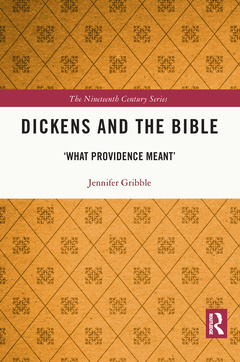Description
Dickens and the Bible
'What Providence Meant'
The Nineteenth Century Series
Author: Gribble Jennifer
Language: English
Subjects for Dickens and the Bible:
Keywords
Bleak House; Providential Meaning; Judeo-Christian grand narrative; Amy Dorrit; German higher criticism; Nature’s Laws; Hermeneutic decipherments; Mrs Clennam; Charles Dickens; Mr Pickwick; Evolutionary science; Mr Dorrit; John Jarndyce; Circumlocution Office; Arthur Clennam; Young Man; Mr Meagles; Mr Merdle; Mrs Dombey; Captain Cuttle; Interpolated Tales; Lady Dedlock; Christ Child; Christmas Carols; Providential Narrative; Dorrit Family; Coal Fires; Pickwick Club; Mr Podsnap; Hero’s Journey; archetypal psychology; archival activism; archival science; archive banditry; Cixous’s works; deconstructive intersectionality; deconstructive praxis; haunting skills; human rights discourses; social justice activism; South African ghosts; spectral archive; spectrality
Publication date: 05-2023
· 15.2x22.9 cm · Paperback
Publication date: 12-2020
· 15.2x22.9 cm · Hardback
Description
/li>Contents
/li>Readership
/li>Biography
/li>
At a time when biblical authority was under challenge from the Higher Criticism and evolutionary science, ?what providence meant? was the most keenly contested of questions. This book takes up the controversial subject of Dickens and religion, and offers a significant contribution to the interdisciplinary area of religion and literature. In a close study of major novels, it argues that networks of biblical allusion reveal the Judeo-Christian grand narrative as key to his development as a writer, and as the ontological ground on which he stands to appeal to ?the conscience of a Christian people?. Engaging the biblical narrative in dialogue with other contemporary narratives that concern themselves with origins, destinations, and hermeneutic decipherments, the inimitable Dickens affirms the Bible?s still-active role in popular culture. The providential thinking of two twentieth-century theorists, Bakhtin and Ricoeur, sheds light on an exploration of Dickens?s narrative theology.
Introduction
1 Contexts
2 In the Beginning: From Pickwick to Scrooge
3 Dombey and Son: ‘What the Waves Were Always Saying’
4 Bleak House: Expecting a Judgement
5 Little Dorrit and the Coming of the Kingdom
6 Last Things: Redemption, Resurrection, and the Life Everlasting
Jennifer Gribble is a graduate of the Universities of Melbourne and Oxford and is Honorary Associate Professor of English at the University of Sydney, where she has taught for most of her academic career. She has published widely on Victorian and Australian Literature. Her previous publications include The Lady of Shalott in the Victorian Novel (1983), Christina Stead (1994), and the 1998 Penguin edition of George Eliot’s Scenes of Clerical Life.
These books may interest you

Dickens, Religion and Society 52.74 €



